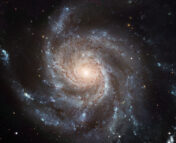Title: Strong chemical tagging with APOGEE: 21 candidate star clusters that have dissolved across the Milky Way disc
Authors: Natalie Price-Jones, Jo Bovy, Jeremy J. Webb, Carlos Allende Prieto, Rachael Beaton, Joel R. Brownstein, Roger E. Cohen, Katia Cunha, John Donor, Peter M. Frinchaboy, D. A. García-Hernández, Richard R. Lane, Steven R. Majewski, David L. Nidever, Alexandre Roman-Lopes
First Author’s Institution: David A. Dunlap Department of Astronomy and Astrophysics, University of Toronto, 50 St George Street, Toronto, ON M5S 3H4, Canada
Status: Published in Monthly Notices of the Royal Astronomical Society, Volume 496, Issue 4, August 2020, Pages 5101–5115 [open access on arXiv]
What is Chemical Tagging?
Imagine, if you will, a pond. Imagine it’s filled with millions of different birds, fish, reptiles, and overall just a thriving ecosystem. If we were ornithologists focused on finding only the male mallard ducks, how would we do that? We could start with basic observations; if a creature is swimming in the pond, you’d probably be unconvinced that it’s a duck just by that. However, if it swam and walked around on the shore, that’s a slightly more convincing argument. If you hear it quacking at you for food (remember, frozen peas, not bread), you may be more firmly convinced it’s a duck. Finally, if it has a yellow bill, green head, and a gray-brown body, you can then be reasonably confident in your assumption that this creature is, in fact, a male mallard duck.
Of course, this is an age-old adage, but its underlying principle is incredibly versatile! When trying to find a particular population (male mallard ducks) within a large sample, we can apply more and more dimensional constraints (what does it walk like, what does it talk like? etc.) to eventually determine what it is (probably a male mallard duck).
Furthermore, with each additional dimension, we grow more confident that the members of our sample are genuine members of our target population. This process is the foundational principle behind chemical tagging: The idea that even after a star cluster, dissolves and its members get lost within the Milky Way, we can still find the members of that cluster using their chemistry.
See, the fantastic thing about stars is that, with few exceptions, their present-day elemental abundance distribution is a fossil record of the chemical composition of the molecular cloud that they formed from. And since stars generally form in clusters, all cluster members also form from the same cloud. Therefore, all the stars in a given cluster should have the same chemistry. Since we don’t expect identical chemistry between clusters, this gives each cluster a unique chemical “tag” that we can, in theory, use to identify its members, even if they’re on opposite sides of the galaxy. But does this idea work?
Finding Lost Stars
Answering that question brings us neatly to today’s paper! Starting from stars observed by the Sloan Digital Sky Survey’s APOGEE program, a group from the University of Toronto attempted a ‘blind chemical tagging’ search in the data to find dissolved open clusters, the simplest and most common variety of star clusters. Using a machine-learning algorithm called a DBSCAN (Density-Based Spatial Clustering of Applications with Noise), the authors studied eight of the best-measured elements published by APOGEE. The reason they chose this particular method is because the goal of a DBSCAN is to detect overdensities in data. Since all stars in a cluster should all have the same measured value for any given element, this should generate an over-density in the data that the DBSCAN can identify. If those stars then show up in other elemental overdensities, you might have yourself a dissolved open cluster.
But did this work? In short, yes! Using their DBSCAN on the red clump and giant stars in APOGEE, the authors recovered 21 dissolved open clusters in the Milky Way!

Furthermore, the authors were able to verify their recovered members in two more independent ways. First, they performed isochrone fitting on their recovered stars, knowing that any false positives shouldn’t fit on the true cluster isochrone. Using isochrones, not only did they find that their identified stars were reasonably good fits, but they were also able to determine that the dissolved clusters ranged between 3 and 10 Gyrs old, as seen in Figure 2.

And lastly, the authors used the orbital parameters of the dissolved clusters to determine whether their stars had ever truly been part of a cluster. This works because conservation of energy dictates that orbital parameters are conserved over a star’s lifetime. As a result, it’s possible to use them to kinematically determine if stars had ever been in a cluster well past the cluster’s death. In this dimension, the study found that the stars were broadly in agreement with each other, though the authors did acknowledge that there was some inaccuracy with their modeling of the Milky Way’s potential. This inaccuracy is primarily due to the fact that the Milky Way isn’t a simple uniform entity. Rather, it has overdensities and under densities, most notably through structures like its spiral arms. This makes perfectly modeling the interactions between stellar bodies and the Milky Way difficult. However, even with that, including the confidence from their isochrone fitting and the chemical similarity across multiple elements, it seems safe to say that the lost stars found here were most likely born together in the same open clusters.
Chemical Tagging in the Future
Chemical tagging, if proven broadly applicable, would open the door to all sorts of new and fascinating studies of the Milky Way’s chemical and dynamical evolution. And due to the advent of large high-precision surveys like APOGEE and Gaia, we might be on the doorstep of those studies. Using data from these surveys, this study was able to look into the murk of the Milky Way’s disk and chemically tag over 20 long dissolved open clusters with high confidence. With larger, more powerful surveys on the horizon such as SDSS-V and LSST, who knows how many more we’ll find?
Astrobite edited by Skyler Grayson and Cole Meldorf
Image Credits: Price-Jones et al. 2021




